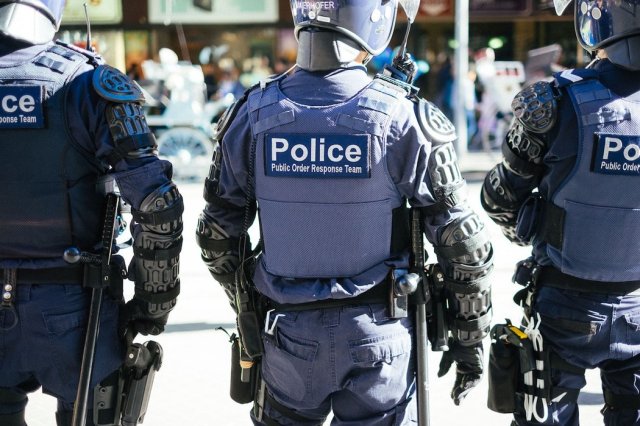
Victorian Treasurer Tim Pallas unveiled his election year state budget on May 1, with highlights including increased investment in public transport, health and education, with more than $172 million dollars allocated to make TAFE free for 30 priority courses.
However, following the trend of previous budgets, there was also an emphasis on law and order, with more than $100 million to increase the number of Victoria Police to more than 3500 and $25 million to fund additional firearms for police.
Law and order
Millions more are being invested in prisons, with $689 million allocated to build a new 700-bed maximum security facility in Lara, along with millions in increased funding for youth prisons, such as Malmsbury and Parkville.
This increased funding for law and order is the response of the Daniel Andrews government to right-wing scaremongering about crime and safety. But the greater police numbers have been increasingly used to repress protests organised by left-wing activists, such as the refugee protests.
Police remain unaccountable for the police brutality and racial profiling that occurs regularly in Victoria. Increased funding for law enforcement is often justified by saying it is for the “safety of all Victorians”, despite the fact that overall crime in Victoria is facing its biggest drop in 12 years.
Meanwhile, the Federation of Community Legal Centres has criticised the budget for its emphasis on prisons and law enforcement, while not giving a single cent to community legal support. CEO of Federation of Community Legal Centres Victoria Serina Mcduff said: “Unfortunately, Premier Andrews has chosen to spend billions on police and prisons, which only make social problems worse, and less on long-term solutions, including community legal support.”
One bright spot in the budget is the $1.9 billion to be put towards addressing family violence.
Environment
Environmental organisations such as Friends of the Earth and Environment Victoria have criticised the budget for doing little to address environmental issues.
Environment Victoria said the budget did little to address the conservation of Victoria’s unique natural areas and threatened species. While it welcomed the $70.6 million allocation over four years towards national park funding, it said there are still large gaps in Victoria’s nature conservation budget.
Friends of the Earth criticised the significant drop in funding for climate change and environment to $266 million from $798 million in the previous year. It noted that the government needs to have some vision when it comes to our environment “such as by establishing the Great Forest National Park and championing the rollout of renewable energy”.
Transport
The government has allocated $1.9 billion to public transport, including the expansion of regional transport lines and improvements in regional infrastructure. More than $1 billion of this has been allocated to metropolitan public transport upgrades, with additional services, station carparking and rail line upgrades being promised by the government.
There is even $50 million allocated to investigate a fast rail link connecting the cities of Melbourne and Geelong.
However, public transport funding remains woefully inadequate when we consider that the budget has allocated more than $4.3 billion for the building of more roads, more than double the amount to be invested in public transport.
The Andrews government has allocated more than $3.3 billion dollars to build the 26-kilometre North East Link, which is facing community opposition. If built, the freeway would jeopardise the construction of a rail line in Doncaster, which remains the only Melbourne metropolitan area without a train or tram line.
The Public Transport Users Association said the budget is business as usual for woefully failing to address the necessary growth in public transport needs: “Victoria is in danger of regressing to a 20th century car-dependent model for transport planning and needs to renew its ambition on public and active transport.”
It said there is an on-going need to “boost regular service frequency, including on our long-neglected suburban bus network” — none of which is addressed in this year’s budget.
Housing Crisis
The budget continues the plan to sell-off of up to 12 public housing estates in inner-city Melbourne under the misleadingly titled Public Housing Renewal Project. There is nothing in the budget to address the increasing unaffordability of housing nor any plans to fund public housing to address the growing public housing waiting list.
Victorian Socialists Northern Metropolitan candidate Stephen Jolly said: “There has been nothing, absolutely nothing, of any substance regarding the housing crisis in this budget.”
Education and health
The best parts of the budget are the increased funding for health and education. The budget has allocated more than $5.7 billion to fund healthcare, with a notable $705 million package to help people with mental health and addiction issues. The package includes $232 million for 89 additional mental health beds and $101 million for six emergency department crisis hubs to respond to patients with drug, alcohol and mental health issues.
The Australian Education Union welcomed the budget’s $3.6 billion funding for public education, which includes pre-schools, schools and TAFES.
The budget includes a $172 million plan to make 30 "high-priority" non-apprenticeship TAFE courses free from next year. Eighteen "Apprenticeship Pathway" courses will also be offered for free. The plan will target aged, mental health and disability care, as well as trades such as building, construction, concreting and waterproofing.
The budget has also allocated $303.8 million to create 30,000 new training places and $120 million to upgrade TAFE campuses in Bendigo, Morwell and Sale.
The Victorian Greens welcomed the investment in education but said this is still a budget that spends far more on roads than on education, public transport or renewable energy.